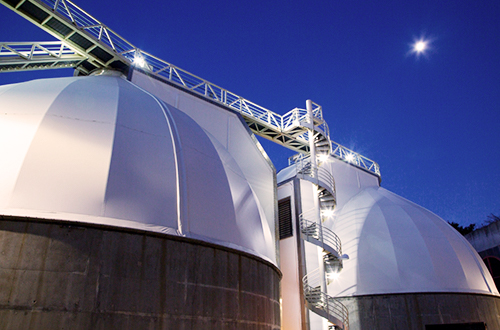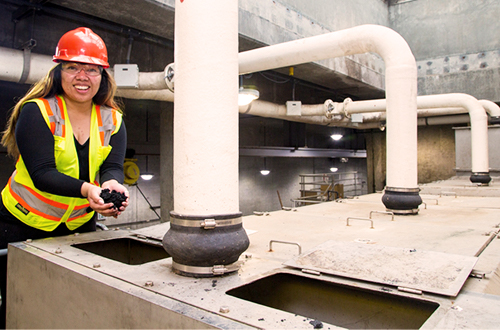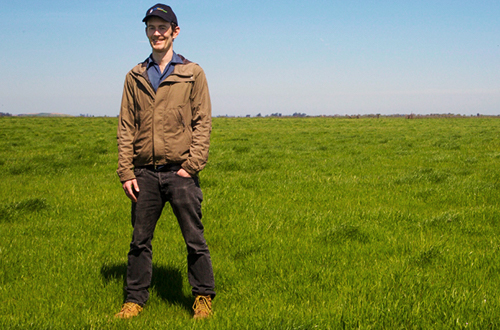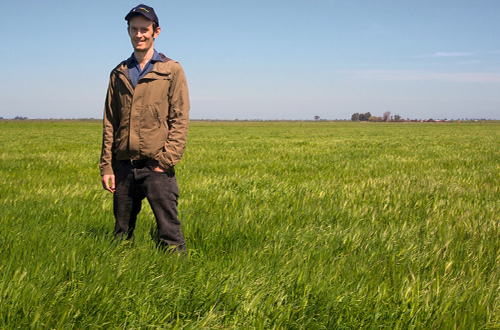Biosolids
Learn how our Biosolids program recycles nutrients from wastewater into a high quality fertilizer that helps reduce water use, pulls carbon dioxide out of the atmosphere, and improves California’s farm soils.
-
What are biosolids?
Every day, we treat and clean millions of gallons of wastewater from toilets, kitchen and bathroom sinks, bathtubs and showers, as well as rainwater that falls on our roofs, streets, and sidewalks. This wastewater contains both liquids and solids. In a complex process, we convert these solids (essentially made of poop and food) into a high quality fertilizer rich in nutrients called “biosolids.” Biosolids are valuable because they allow us to recover soil nutrients and carbon, and return these elements back to the soils where they came from.
-
How are biosolids made?
The dirty water you send down your drains in San Francisco ends up at either the Southeast Treatment Plant in the Bayview neighborhood or at the Oceanside Treatment Plant by the Zoo. The solids are separated from the water, and then biologically treated in massive tanks called “anaerobic digesters.” This is an image of the top of an anaerobic digester at the Oceanside Treatment Plant. It can hold 750,000 gallons of material.

Inside the digesters, the solids are heated and are fed to microorganisms. The microorganisms kill harmful pathogens, break down pollutants, and produce methane gas, which can then be captured and used as a 100% renewable energy source. After several weeks of treatment in the anaerobic digesters, the microorganisms have completed their job transforming the solids into a nutrient rich compost and soil-like fertilizer called biosolids.
The last step is to remove excess water. The picture below shows a press that is used to squeeze water out of the biosolids. Then the biosolids are ready to be used as a renewable fertilizer. We work closely with a team of service providers and ranchers that use our biosolids to ensure we are meeting the needs of the soils and ranches we work for.

If you would like to learn more about this process, please watch this video produced by the San Francisco Academy of Sciences explaining how biosolids are made.
-
Why are biosolids a valuable fertilizer?
We get the nutrients we need to live from the plants we eat (or by eating the animals that ate those plants). These plants get their nutrients from the soil where they grew. When plants are harvested, those nutrients are removed from the soil. Unless these nutrients are returned back to the earth or replaced with another fertilizer source, soil productivity eventually collapses. These soil nutrients can be replaced using chemical fertilizers, manures, compost, or biosolids. Chemical fertilizers either require large amounts of fossil fuels to create (nitrogen fertilizer production accounts for 3 percent of global natural gas consumption) or are destructively mined from finite deposits in the Earth. As a society, we need to recycle these valuable soil nutrients from the systems we manage. Biosolids are an obvious way to recycle soil nutrients and carbon that have come from farms and return them back to soils.
Here are some of the benefits of biosolids when used as a fertilizer:
- Biosolids provide the essential nutrients plants need so there is no need to purchase chemical fertilizers. Plant nutrients are supplied steadily over the course of the growing season, meaning plants grow better.
- The structure of soil is improved as biosolids increase aggregation (good clumps) in the soil.
- Erosion is reduced because biosolids improve soil structure and aggregation.
- Biosolids increase the amount of water that soils can hold, meaning farmers need less irrigation water and rain water is less likely to run off fields.
- The carbon in biosolids is a food source for soil microbial life, which helps build and maintain healthy soils.
- Soil can hold on to more plant nutrients after biosolids application.
- Soils that receive biosolids can sequester larger amounts of carbon, which helps address climate change.
If you would like to learn more about how SFPUC biosolids are used as a fertilizer and why, visit the Bay Area Biosolids Coalition website.
-
Who uses SFPUC biosolids?
The biosolids created in our programs are used by California ranchers to fertilize and improve fields that grow oats, wheat, triticale, rye, sudan grass, and other pasture crops used for livestock feed. When farmers use biosolids, it benefits everyone because they are reducing water use, pulling CO2 out of the atmosphere, and improving California’s farm soils.
While soil may not seem like an important resource at first, it is the source of nearly all our food. Severe degradation of soils can lead to catastrophic environmental disasters like the Dust Bowl. SFPUC Biosolids are strengthening California’s soils at a time when drought and rising temperatures are putting increased strain on their productivity and health.
Farmers like to use biosolids because of all these important benefits. You can see in the pictures below the difference in two adjacent fields, one where biosolids have been used and one where they have not been used. The fields are not divided by a fence and are grazed at the same time. The picture of the two different fields was taken on the same day.

Photo of a field where biosolids have not been used.

Photo of adjacent field where biosolids have been used.
-
Carbon sequestration with biosolids
Every second, plants all over the world are using photosynthesis to pull carbon dioxide (CO2) out of the atmosphere and turn it into carbon chains that make up plant matter. When plants shed roots, drop leaves, or die, the carbon from this material can be stored in the soil. The carbon contained in plants and soils accounts for 2,300,000,000,000 tons of carbon. This is almost three times the amount of carbon held in the atmosphere as greenhouse gasses. Much of our planet’s soils have been degraded. In fact, agricultural soils have lost 30 to 75 percent of their carbon to the atmosphere. This means soils around the world have the capacity to be replenished to store more carbon.
Biosolids can make plants grow faster and stronger, meaning plants pull more CO2 from the atmosphere. Research shows that soils that have been fertilized with biosolids store significantly more carbon. Using biosolids is one way to increase soil carbon and improve soil quality–it’s an easy way for us to have a big impact and do the right thing.
-
Quality and testing
We monitor our biosolid closely, regularly testing them to ensure they meet stringent government requirements. We also conduct additional testing and monitoring above and beyond what is required, and biosolids are already more closely monitored than any other soil amendment, manure, compost or fertilizer on the market. We rely on research from the Environmental Protection Agency (EPA), leading universities, and environmental research foundations to continue to ensure the safety and effectiveness of our biosolids. Studies by UC Davis specifically performed on SFPUC Biosolids have shown them to be a safe way to return nutrients and carbon to soil.
Our Biosolids Program is certified as a platinum level program, the highest level possible, by the National Biosolids Partnership for our continued focus on producing high quality biosolids that have a positive environmental impact. Our program is audited by a third party to ensure continuous improvement in the areas of environmental performance, regulatory compliance, quality management practices, and relations with interested parties and stakeholders. To learn about how we manage our biosolids program, please check out the biosolids fact sheet. You can also find supporting information in the Biosolids Annual Report details.


